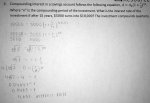Solving for the variable in an exponential function
- Thread starter June
- Start date
HallsofIvy
Elite Member
- Joined
- Jan 27, 2012
- Messages
- 7,763
That's what the logarithm is for! In fact, that is how the logarithm is defined. If 310000=(1.13)t then, taking the logarithm of both sides, log(310000)=log(1.13t)=tlog(1.13). x=log(1.13)log(310000).
Your calculator probably has two logarithm buttons- the "common" logarithm, base 10, and the "natural" logarithm, base e. As long as you use the same logarithm throughout a calculation, it doesn't matter which you use.
For (1+4r)60=51, since the unknown, r, is NOT in the exponent itself, you do not need a logarithm. Instead, get rid of the exponent, 60, by doing the opposite of taking the 60th power- take the 60th root or 1/60 power:
1+4r=(51)1/60.
Now subtract 1 from both sides: 4r=(51)1/60−1.
And last, of course, multiply both sides by 4: r=4(51)1/60−4.
That the exact solution and I, personally, would prefer it over an approximate, numerical solution. But it is not difficult to get that using a calculator. 1/5 is, of course, 0.2. The 60th root, or 1/60 power of 0.2 is, according to my calculator, 0.97353260205103889369927709540881. Multiplying by 4, that gives 3.8941304082041555747971083816352 and subtracting 4,
r= -0.10586959179584442520289161836478
Your calculator probably has two logarithm buttons- the "common" logarithm, base 10, and the "natural" logarithm, base e. As long as you use the same logarithm throughout a calculation, it doesn't matter which you use.
For (1+4r)60=51, since the unknown, r, is NOT in the exponent itself, you do not need a logarithm. Instead, get rid of the exponent, 60, by doing the opposite of taking the 60th power- take the 60th root or 1/60 power:
1+4r=(51)1/60.
Now subtract 1 from both sides: 4r=(51)1/60−1.
And last, of course, multiply both sides by 4: r=4(51)1/60−4.
That the exact solution and I, personally, would prefer it over an approximate, numerical solution. But it is not difficult to get that using a calculator. 1/5 is, of course, 0.2. The 60th root, or 1/60 power of 0.2 is, according to my calculator, 0.97353260205103889369927709540881. Multiplying by 4, that gives 3.8941304082041555747971083816352 and subtracting 4,
r= -0.10586959179584442520289161836478
Last edited:
The negative r value is an error. That should have been a red flag, because the amount of money is growing.
The next two equations should be, after the first correctly written equation, the equivalent of:
(1 + 4r)60 = 5,00010,000
(1 + 4r)60 = 2
The next two equations should be, after the first correctly written equation, the equivalent of:
(1 + 4r)60 = 5,00010,000
(1 + 4r)60 = 2




